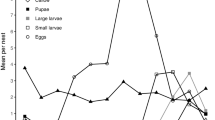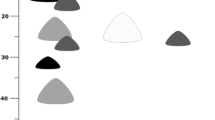Abstract
Fisher's theory of sex allocation predicts that, in a panmictic population, parental investment will be equally distributed between male and female progeny. Most studies on parental investment in nesting solitary bees and wasps use offspring or provision weight as estimators of parental investment and do not corroborate Fisher's theory. The measurement of parental investment may be confounded by several factors. First, the use of offspring or provision size does not account for seasonal variation in foraging costs associated with aging of nesting females. Second, provision or offspring size do not reflect parental investment associated with nest construction. In this two-year study we measured parental investment in a solitary bee. We calculated sex allocation using both provision weight and foraging time as parental investment estimators. Investment in pollen-nectar provisions decreased, while investment in mud structures (nest construction) increased, as the nesting period progressed. Overall investment in provisions per nest was ∼25 times higher than investment in mud. Pollen-nectar foraging trips became longer as the season progressed, but mud trip duration did not vary. Due to weather differences between years, more offspring per female were produced in the first year, but progeny sex ratio and mean offspring size of both sexes were similar between years. Mortality did not differ between sexes. As predicted by Fisher's theory, production cost ratios did not differ from 1 in either year, irrespective of the currency used to estimate parental investment (provision weight or foraging time). Our results strongly support Fisher's theory.



Similar content being viewed by others
References
Boomsma JJ (1989) Sex-investment ratios in ants: has female bias been systematically overestimated? Am Nat 133:517–532
Bosch J (1994a) Improvement of field management of Osmia cornuta (Latreille) (Hymenoptera, Megachilidae). Apidologie 25:71–83
Bosch J (1994b) The nesting behaviour of the mason bee Osmia cornuta (Latr) with special reference to its pollinating potential (Hymenoptera, Megachilidae). Apidologie 25:84–93
Bosch J, Kemp WP (2004) Effect of pre-wintering and wintering temperature regimes on weight loss, survival, and emergence time in the mason bee Osmia cornuta (Hymenoptera: Megachilidae). Apidologie 35:469–479
Bosch J, Vicens N (2002) Body size as an estimator of production costs in a solitary bee. Ecol Entomol 27:129–137
Brockman HJ, Grafen A (1992) Sex ratios and life-history patterns of a solitary wasp, Trypoxylon (Trypargilum) politum (Hymenoptera: Sphecidae). Behav Ecol Sociobiol 30:7–27
Charnov EL, Los-den-Hartog RL, Jones WT, van den Assen J (1981) Sex ratio evolution in a variable environment. Nature 289:27–33
Cowan DP (1981) Parental investment in two solitary wasps Ancistrocerus adiabatus and Euodynerus foraminatus (Eumenidae: Hymenoptera). Behav Ecol Sociobiol 9:95–102
Danforth BN (1990) Provisioning behaviour and the estimation of investment ratios in a solitary bee, Calliopsis (Hypomacrotera) persimilis (Cockerell) (Hymenoptera: Andrenidae). Behav Ecol Sociobiol 27:159–168
Field J (1992) Patterns of nest provisioning and parental investment in the solitary wasp Ammophila sabulosa. Ecol Entomol 17:3–51
Fisher RA (1958) The genetical theory of natural selection, 2nd edn. Dover, New York
Frank SA, Swingland IR (1988) Sex ratio under conditional sex expression. J Theor Biol 135:415–418
Freeman BE (1981) Parental investment, maternal size and population dynamics of a solitary wasp. Am Nat 117:357–362
Frohlich DR, Tepedino VJ (1986) Sex ratio, parental investment, and interparental variability in nesting success in a solitary bee. Evolution 40:142–151
Gerber HS, Klostermeyer EC (1970) Sex control by bees: a voluntary act of egg fertilization during ovoposition. Science 167:82–84
Hamilton WD (1967) Extraordinary sex ratios. Science 156:477–488
Helms K (1994) Sexual size dimorphism and sex ratios in bees and wasps. Am Nat 143:418–434
Herre EA (1985) Sex ratio adjustment in fig wasps. Science 228:896–898
Johnson MD (1988) The relationship of provision weight to adult weight and sex ratio in the solitary bee, Ceratina calcarata. Ecol Entomol 13:165–170
Kim J-Y (1999) Influence of resource level on maternal investment in a leaf-cutter bee (Hymenoptera: Megachilidae). Behav Ecol 10:552–556
Klostermeyer EC, Mech SJ, Rasmussen WB (1973) Sex and weight of Megachile rotundata (Hymenoptera: Megachilidae) progeny associated with provision weights. J Kansas Entomol Soc 46:536–548
Krombein KV (1967) Trap-nesting wasps and bees. Smithsonian Press, Washington, DC
Maeta Y (1978) Comparative studies on the biology of the bees of the genus Osmia in Japan, with special reference to their management for pollination of crops (Hymenoptera, Megachilidae). Bull Tohoku Nat Agric Exp Stn 57:1–221 [in Japanese]
Martins RP, Antonini Y, da Silveira FA, West SA (1999) Seasonal variation in the sex allocation of a neotropical solitary bee. Behav Ecol 10:552–556
O’Neill KM (2001) Solitary wasps, behavior and natural history. Cornell University Press, Ithaca
Paini DR, Bailey WJ (2002) Seasonal sex ratio and unbalanced investment sex ratio in the Banksia bee Hylaeus alcyoneus. Ecol Entomol 27:713–719
Rosenheim JA, Nonacs P, Mangel M (1996) Sex ratios and multifaceted parental investment. Am Nat 148:501–535
Rust RW (1993) Cell and nest construction costs in two cavity-nesting bees (Osmia lignaria propinqua and Osmia ribifloris biedermannii) (Hymenoptera: Megachilidae). Ann Entomol Soc Am 86:327–332
Smith CC, Fretwell SD (1974) The optimal balance between size and number of offspring. Am Nat 108:499–506
Stark RE (1992) Sex ratio and maternal investment in the multivoltine large carpenter bee Xylocopa sulcatipes (Apoidea: Anthophoridae). Ecol Entomol 17:160–166
Strohm E, Linsenmair KE (1997) Low resource availability causes extremely male-biased investment ratios in the European beewolf, Philantus triangulum F. (Hymenoptera, Sphecidae). Proc R Soc Lond B 264:423–429
Strohm E, Linsenmair KE (1999) Measurement of parental investment and sex allocation in the European beewolf Philantus triangulum F. (Hymenoptera: Sphecidae). Behav Ecol Sociobiol 47:76–88
Strohm E, Linsenmair KE (2000) Allocation of parental investment among individual offspring in the European beewolf Philantus triangulum F. (Hymenoptera: Sphecidae). Biol J Linn Soc 69:173–192
Sugiura N, Maeta Y (1989) Parental investment and offspring sex ratio in a solitary mason bee, Osmia cornifrons (Radoszkowski) (Hymenoptera, Megachilidae). Jpn J Entomol 57:861–875
Tepedino VJ, Torchio PF (1982a) Phenotypic variability in the nesting success among Osmia lignaria propinqua females in a glasshouse environment (Hymenoptera: Megachilidae). Ecol Entomol 7:453–462
Tepedino VJ, Torchio PF (1982b) Temporal variability in the sex ratio of a non-social bee, Osmia lignaria propinqua: extrinsic determination or the tracking of an optimum? Oikos 38:177–182
Tepedino VJ, Torchio PF (1989) The influence of nest-hole selection on sex ratio and progeny size in Osmia lignaria propinqua (Hymenoptera: Megachilidae). Ann Entomol Soc Am 82:355–360
Torchio PF (1989) In-nest biologies and immature development of three Osmia species (Hymenoptera: Megachilidae). Ann Entomol Soc Am 82:599–615
Torchio PF, Tepedino VJ (1980) Sex ratio, body size, and seasonality in a solitary bee, Osmia lignaria propinqua Cresson (Hymenoptera: Megachilidae). Evolution 34:993–1003
Trivers RL, Hare H (1976) Haplodiploidy and the evolution of the social insects. Science 191:249–263
Trivers RL, Willard DE (1973) Natural selection of parental ability to vary the sex ratio of offspring. Science 179:90–92
Vicens N, Bosch J (2000) Weather-dependent pollinator activity in an apple orchard, with special reference to Osmia cornuta and Apis mellifera (Hymenoptera: Megachilidae and Apidae). Environ Entomol 29:413–420
Visscher PK, Danforth BN (1993) Biology of Calliopsis pugionis (Hymenoptera: Andrenidae): nesting, foraging, and investment sex ratio. Ann Entomol Soc Am 86:822–832
Willmer PG (1985) Thermal ecology, size effects, and the origins of communal behaviour in Cerceris wasps. Behav Ecol Sociobiol 17:151–160
Acknowledgements
We thank the owners of the Sant Daniel farm for allowing us to work in their property. We are grateful to J. Juanola for assistance with night counts, and to J. Calzadilla, M. A. Escolano, M. López and V. H. Monzón for their generous help with nest dissection and analysis. E. García (Universitat de Girona) and X. Picó (CREAF, Barcelona) provided advice and stimulating discussions during different phases of the study. V. J. Tepedino (USDA-ARS, Bee Biology and Systematics Laboratory), T. Roulston (University of Virginia) and J. Retana (Universitat Autònoma de Barcelona) reviewed a draft of the manuscript, and made suggestions for its improvement. This study was supported by the DGICYT (project AGR. 91-0988-CO3) and by a FPI grant from the Spanish MEC to N. Vicens, and complies with current laws in Spain
Author information
Authors and Affiliations
Corresponding author
Additional information
Communicated by R.F.A. Moritz
Rights and permissions
About this article
Cite this article
Bosch, J., Vicens, N. Sex allocation in the solitary bee Osmia cornuta: do females behave in agreement with Fisher's theory?. Behav Ecol Sociobiol 59, 124–132 (2005). https://doi.org/10.1007/s00265-005-0017-8
Received:
Revised:
Accepted:
Published:
Issue Date:
DOI: https://doi.org/10.1007/s00265-005-0017-8




